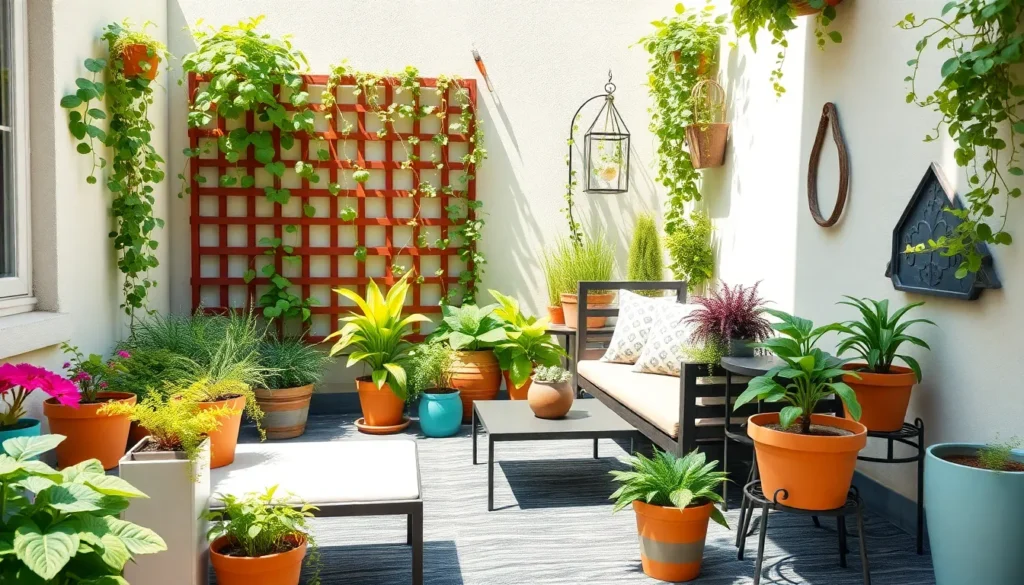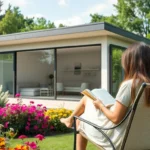We’ve all dreamed of having a lush garden but felt limited by small outdoor spaces. Your tiny patio doesn’t have to mean sacrificing your gardening dreams – it just means getting creative with every square inch you’ve got.
Small patio gardens pack incredible potential into compact spaces. Whether you’re working with a narrow balcony or a postage-stamp-sized deck we’ll show you how to transform any petite outdoor area into a thriving green oasis. From vertical growing answers to clever container arrangements these space-saving strategies prove that size doesn’t determine success.
The best small patio gardens combine function with beauty creating outdoor retreats that feel surprisingly spacious. We’re about to share practical ideas that maximize your growing potential while keeping maintenance simple and enjoyable.
Create Vertical Gardens to Maximize Growing Space
Vertical gardening transforms blank walls and empty air space into productive growing areas. We can triple our planting capacity by thinking upward instead of outward.
Install Wall-Mounted Planters and Trellises
Wall-mounted planters create instant garden space without consuming valuable floor area. We can attach pocket planters, hanging baskets, and modular growing systems directly to fence panels, exterior walls, or sturdy railings.
Trellis systems work perfectly for climbing vegetables like beans, peas, and cucumbers. Mount cedar or metal trellises 6-8 inches away from walls to allow proper air circulation. We recommend spacing mounting brackets every 2-3 feet for adequate support.
Pocket planters hold herbs, lettuce, and small flowering plants in compact felt or plastic compartments. These systems typically accommodate 6-12 plants per square yard of wall space. Choose models with built-in drainage to prevent root rot.
Rail planters attach to deck railings and balcony edges using adjustable clamps. We can grow cherry tomatoes, herbs, and trailing flowers in these space-saving containers. Most rail planters measure 24-36 inches long and hold 2-4 plants each.
Use Ladder Shelving for Tiered Plant Displays
Ladder shelving creates multiple growing levels while maintaining easy access to all plants. We can position wooden or metal ladder stands against walls or use them as freestanding displays.
A-frame ladders provide stable platforms for 6-8 containers across three to four tiers. Place larger plants like peppers and small tomatoes on lower shelves, with herbs and flowers on upper levels. Standard A-frame ladders support 20-30 pounds per shelf.
Leaning ladder displays work well in corner spaces where traditional shelving won’t fit. We can arrange 4-6 planters on each side, creating cascading displays of vegetables and flowers. Secure leaning ladders to walls using safety brackets.
Step-style plant stands offer graduated heights that showcase plants beautifully while maximizing sun exposure. These tiered systems typically accommodate 8-12 containers and measure 3-4 feet wide. We prefer models with slatted shelves that allow water drainage.
Hang Plants from Ceiling Hooks and Brackets
Hanging gardens use overhead space that would otherwise remain empty. We can suspend trailing plants, herbs, and compact vegetables from sturdy ceiling hooks, pergola beams, or umbrella frames.
Ceiling hooks must support 15-25 pounds when planted containers are fully watered. Install hooks into ceiling joists or use heavy-duty toggle bolts for solid mounting. Space hooks 18-24 inches apart for optimal plant spacing.
Swivel brackets allow us to rotate hanging plants toward sunlight throughout the day. These adjustable mounts work particularly well for herb gardens and cherry tomato plants. We can grow basil, oregano, and compact pepper varieties in 8-10 inch hanging baskets.
Pulley systems make watering and maintenance easier by lowering plants to comfortable heights. Install simple rope and pulley arrangements for heavier containers like hanging tomato planters. We recommend this system for containers weighing more than 10 pounds when watered.
Macrame and chain hangers support lightweight herb gardens and flowering plants beautifully. These decorative hanging systems work well for plants requiring frequent harvesting like lettuce, spinach, and cutting herbs. Choose hangers rated for at least twice the expected plant weight for safety.
Choose Multi-Functional Furniture with Built-In Planters
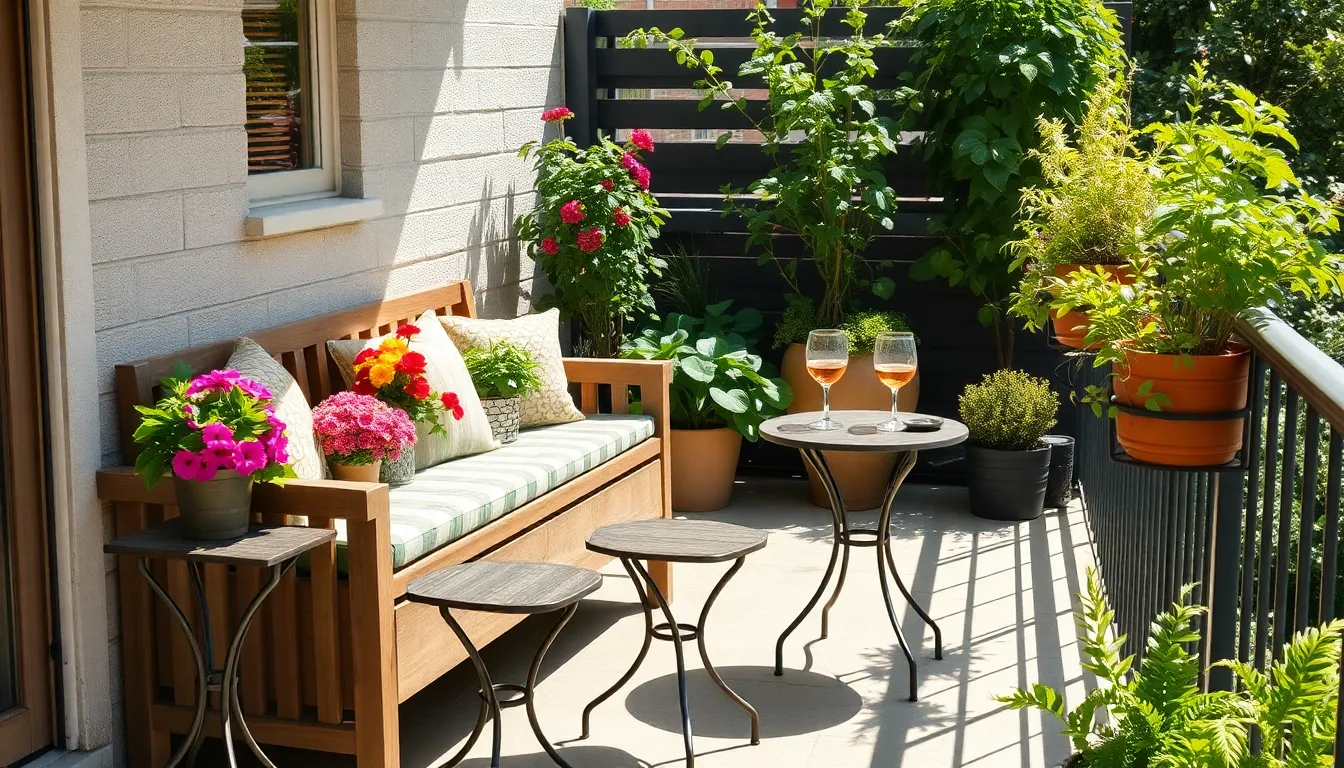
Smart furniture answers transform our small patio gardens by combining seating, storage, and planting space into single functional pieces. We’ll maximize every square inch while maintaining comfort and style in our compact outdoor areas.
Select Storage Benches with Planting Compartments
Storage benches with built-in planters create the perfect solution for small patio organization and garden display. We can store essential garden tools, patio cushions, or outdoor accessories inside the bench compartment while growing colorful flowers or herbs in the integrated planter sections. These dual-purpose pieces eliminate clutter from our patio floors and provide comfortable seating for outdoor relaxation. Our storage benches enhance the aesthetic appeal by combining practical functionality with living plant elements that soften hard surfaces.
Incorporate Plant Stands That Double as Side Tables
Plant stands that function as side tables give us additional surface area for outdoor dining and entertaining while keeping plants at eye level. We position these versatile pieces next to seating areas to hold drinks, books, or decorative items on the table surface while displaying our favorite plants below. Elevated plants receive better sunlight exposure and remain more visible as focal points in our small patio design. These multi-functional stands work particularly well for showcasing trailing plants like pothos or displaying seasonal flowers that complement our outdoor color scheme.
Install Railing Planters for Space-Saving Answers
Railing planters use our vertical patio space without sacrificing precious floor area for walking or seating. We attach these planters directly to deck railings, balcony edges, or fence lines to create instant growing space for herbs, succulents, or compact vegetables. This mounting approach keeps plants accessible for daily watering and harvesting while freeing up ground space for furniture placement. Our railing planters work exceptionally well for growing kitchen herbs like basil, oregano, and thyme that we can easily reach while cooking outdoors.
Design Container Gardens for Easy Maintenance
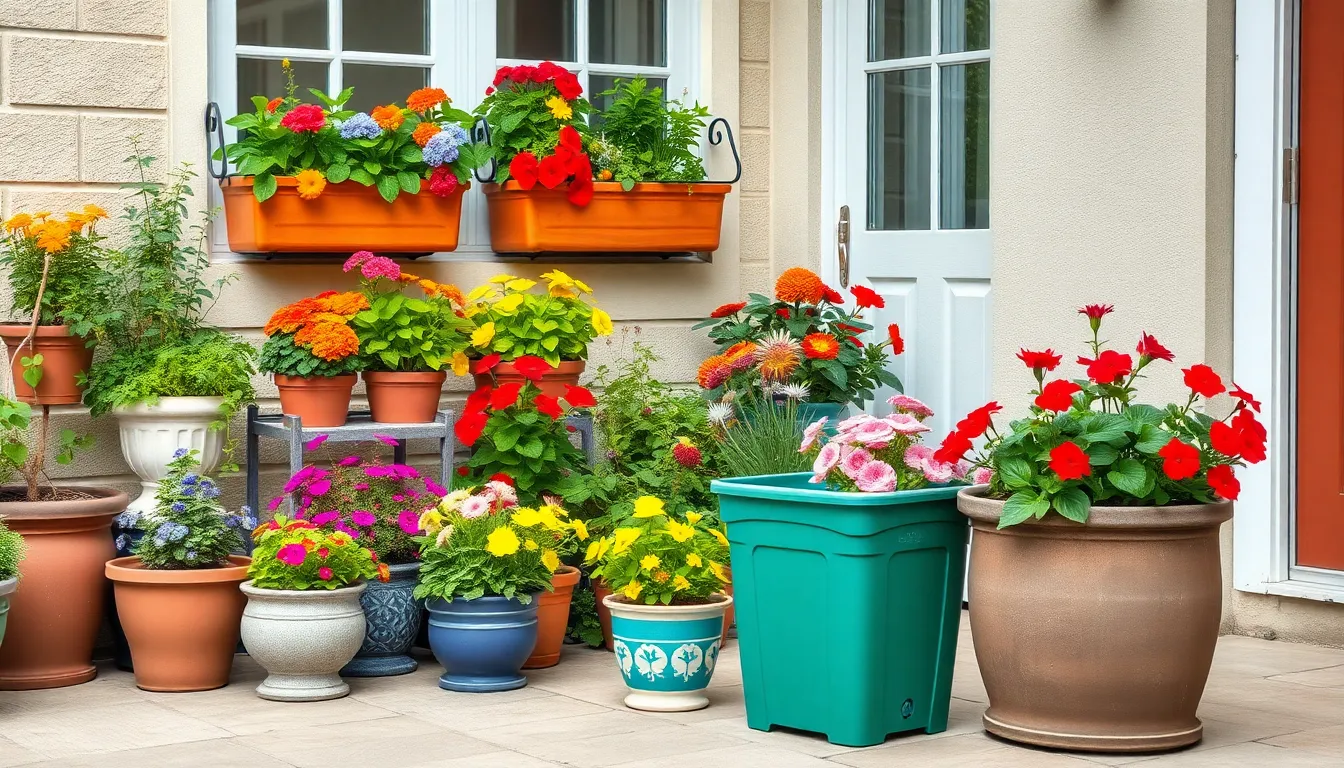
Container gardening transforms small patio spaces into manageable growing areas. We’ll explore effective strategies that maximize your space while keeping maintenance simple.
Group Plants in Decorative Pots and Planters
Strategic plant grouping creates visual impact while simplifying care routines. We recommend selecting plants with similar watering and sunlight requirements, such as pairing Mediterranean herbs like rosemary and lavender together. Tiered planters work particularly well for small patios, adding vertical interest without consuming valuable floor space.
Decorative pot arrangements allow us to create themed collections that enhance your patio’s aesthetic appeal. Consider grouping colorful annuals like petunias and marigolds in matching ceramic containers for a cohesive look. This approach makes watering and fertilizing more efficient since plants with similar needs stay together.
Different sized containers create depth and visual hierarchy in your arrangement. We suggest placing larger statement pots as focal points with smaller accent planters surrounding them. This method maximizes growing space while maintaining an organized appearance that’s easy to maintain.
Create Herb Gardens in Window Boxes
Window boxes offer versatile growing answers for small patio spaces. We can mount these containers under windows or along patio railings to maximize vertical growing area without sacrificing floor space. Fresh herbs like basil, thyme, and rosemary thrive in these compact growing environments.
Easy access makes window box herb gardens particularly practical for daily cooking needs. Position boxes at comfortable heights for harvesting, ensuring you can reach all plants without stretching or bending. This setup works especially well for frequently used herbs that require regular harvesting.
Multiple window boxes create extensive growing capacity along patio perimeters. We recommend using lightweight materials like fiberglass or resin to prevent structural stress on mounting surfaces. Proper drainage remains crucial, so ensure each box has adequate drainage holes to prevent waterlogged roots.
Use Self-Watering Containers for Low-Maintenance Care
Self-watering systems reduce daily maintenance while ensuring consistent plant hydration. These containers feature built-in water reservoirs that allow plants to draw moisture as needed, eliminating guesswork from watering schedules. We find this technology particularly valuable for busy gardeners or during vacation periods.
Reservoir systems work through capillary action, delivering steady moisture to plant roots. Fill indicators show when water levels need replenishing, typically every 1-2 weeks depending on plant size and weather conditions. This method prevents both overwatering and drought stress that commonly affects container plants.
Various self-watering options suit different plant types and patio aesthetics. We recommend larger reservoirs for vegetables and flowering plants that require consistent moisture, while smaller systems work well for herbs and succulents. These containers prove especially beneficial during hot summer months when traditional pots require daily watering.
Establish Defined Growing Zones for Better Organization
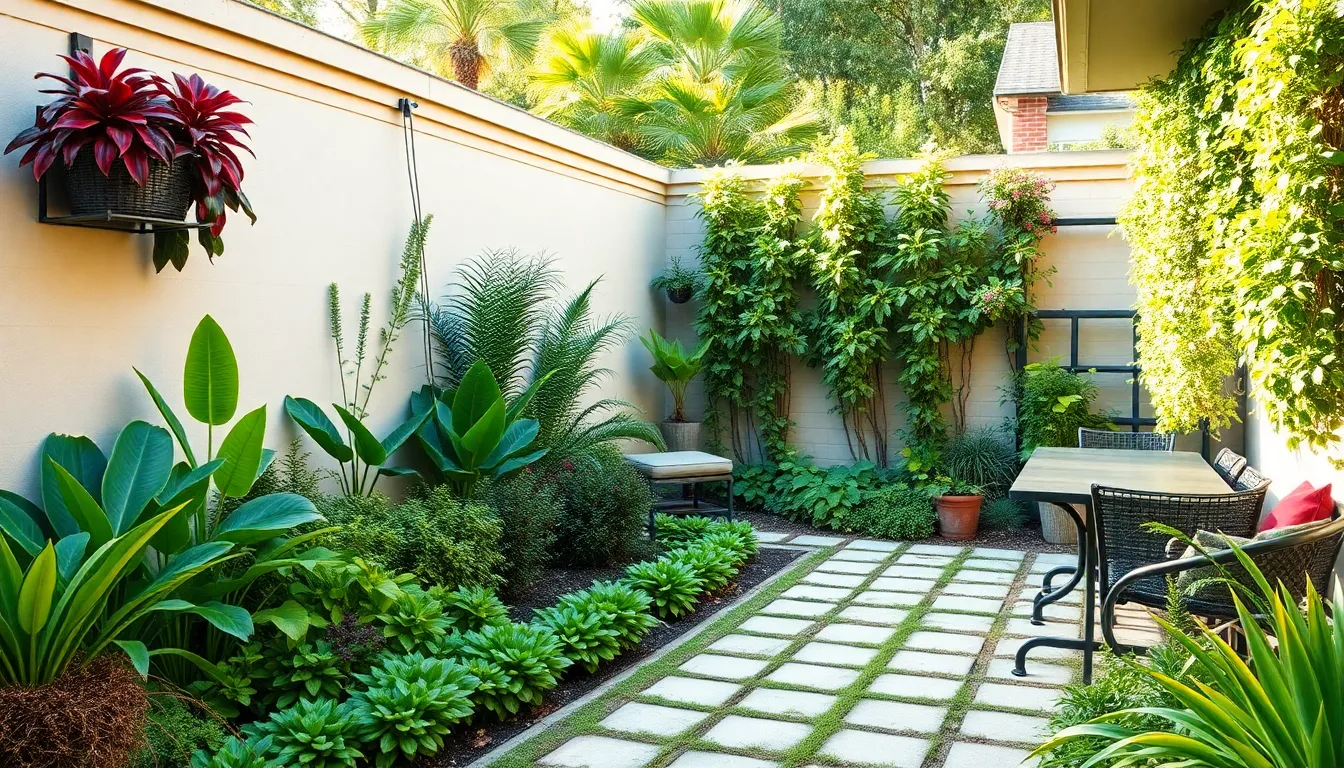
Organizing our small patio garden into distinct zones creates structure while maximizing every inch of available space. Strategic zone planning transforms chaotic arrangements into functional growing areas that enhance both plant health and visual appeal.
Designate Corners for Larger Statement Plants
Corners serve as natural focal points where we can showcase larger plants that command attention without overwhelming the space. Position substantial plants like dwarf fruit trees, large flowering shrubs, or architectural succulents in these areas to create visual anchors. Balance these statement pieces with smaller companion plants arranged around their base to maintain proportion. Choose plants that complement our patio’s style, such as ornamental grasses for modern spaces or flowering bushes for cottage aesthetics. We’ll find that corner placement maximizes floor space while creating dramatic height variations throughout our garden.
Create Pathways Using Strategic Plant Placement
Pathways guide movement through our patio garden while defining separate functional areas within the limited space. Use low-growing plants like creeping thyme, moss, or compact groundcovers to border walkways and create natural transitions. Arrange taller plants behind these border plants to establish clear sight lines and prevent crowding. Position containers at varying heights along pathway edges to create visual rhythm and maintain easy navigation. Strategic plant placement ensures we can access all areas of our garden for maintenance while creating an inviting flow that draws visitors through the space.
Separate Dining and Growing Areas with Plant Screens
Plant screens provide natural division between dining and gardening zones without installing permanent structures that might overwhelm small spaces. Install trellises covered with climbing vines like jasmine, clematis, or edible peas to create living walls that offer privacy and beauty. Position tall planters filled with bamboo, ornamental grasses, or upright herbs to form flexible barriers that can be moved as needed. Use these green dividers to block unsightly views while maintaining airflow and natural light throughout both areas. We can easily adjust these plant screens seasonally to accommodate different activities and growing patterns.
Select Compact Plant Varieties Perfect for Small Spaces
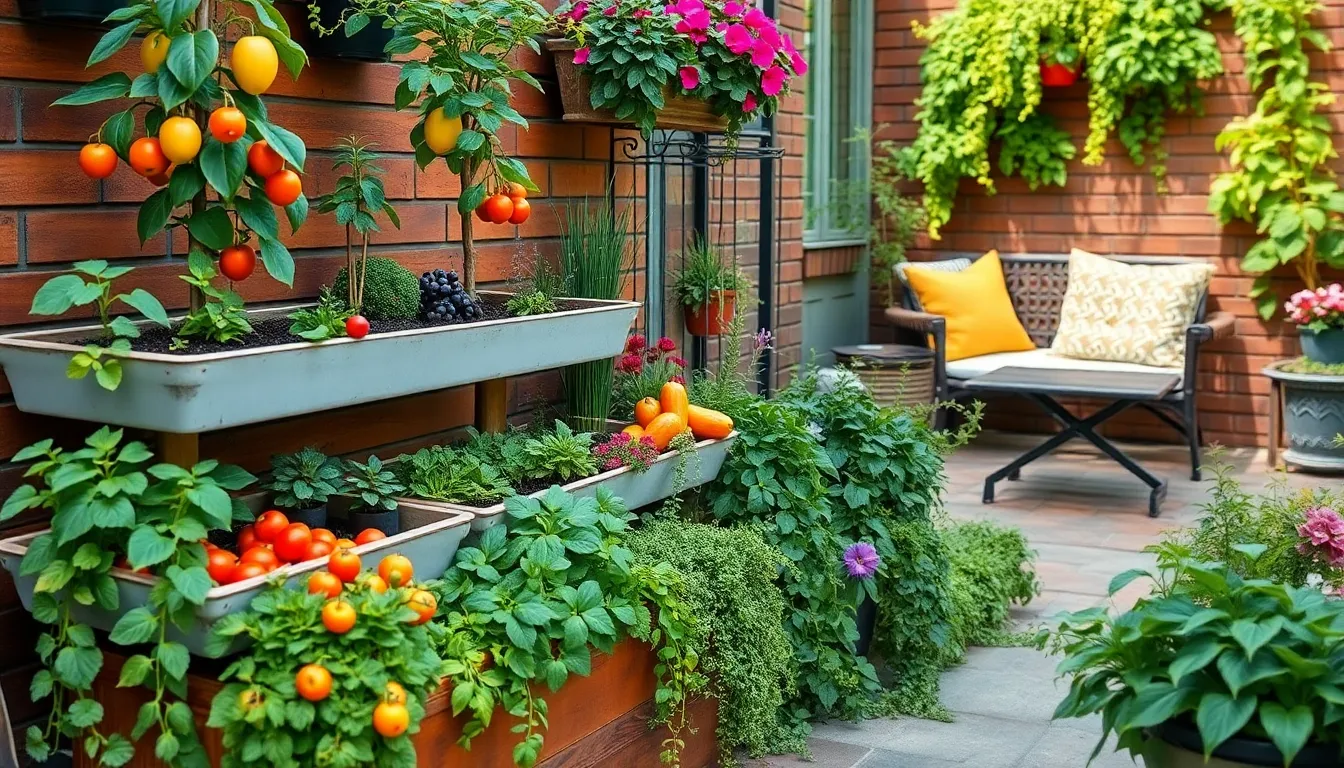
We’ve established our garden zones and containers, now let’s focus on choosing plants that maximize our limited growing space. Smart plant selection makes the difference between a cramped garden and a thriving outdoor retreat.
Choose Dwarf Fruit Trees and Compact Vegetables
Dwarf fruit trees offer exceptional value for small patio gardens. These compact varieties like dwarf apple, cherry, and peach trees deliver full-sized fruit while staying manageable in size. We recommend these space-efficient options because they’re easy to maintain and thrive in containers without overwhelming our limited square footage.
Compact vegetables transform tiny spaces into productive food gardens. Dwarf varieties of tomatoes, peppers, and cucumbers provide abundant harvests while fitting perfectly in our container setups. These scaled-down plants require less support and spacing than their full-sized counterparts, making them ideal for our patio environment.
Container compatibility makes these plants perfect partners for our established growing zones. Both dwarf fruit trees and compact vegetables adapt well to the tiered planters and decorative pots we’ve already arranged. Their controlled growth patterns ensure they won’t outgrow their designated spaces or interfere with our carefully planned garden layout.
Plant Space-Saving Herbs and Microgreens
Herbs maximize flavor potential in minimal space requirements. Basil, mint, and thyme thrive in containers and tiered planters, providing fresh ingredients for our kitchen while adding aromatic appeal to our patio. These versatile plants complement our existing container arrangements and can be easily integrated into our herb garden window boxes.
Microgreens deliver maximum nutrition from the smallest growing areas. These young versions of leafy greens pack impressive nutritional density while requiring only shallow containers and minimal space. We can grow multiple varieties simultaneously in our existing planters without competing for the premium real estate we’ve allocated to larger plants.
Strategic placement enhances both accessibility and visual appeal. Position herbs in our easily accessible containers near seating areas for convenient harvesting during meal preparation. Microgreens work perfectly in our window boxes and tiered displays, creating textural interest while serving as living garnishes for our daily meals.
Incorporate Trailing Plants for Cascading Effects
Trailing plants create dramatic vertical interest from our existing containers. Ivy, creeping thyme, and flowering vines like petunias naturally cascade from elevated planters and wall-mounted containers. These flowing plants add movement and softness to our structured garden zones while maximizing our vertical growing space.
Cascading effects enhance our multi-level garden design. When we position trailing plants in our ladder shelving and hanging containers, they create natural connections between different growing levels. This integration makes our small space feel more cohesive and visually expansive than traditional flat plantings.
Wall and container integration amplifies our space-saving strategies. Train flowering vines along our existing trellises and let trailing plants spill from our railing planters to create living walls. These cascading elements work with our established vertical systems while adding color and texture that draws the eye upward, making our patio feel larger and more lush.
Add Lighting Solutions to Extend Growing Seasons

Proper lighting transforms small patio gardens into productive year-round growing spaces. Strategic lighting answers help us overcome seasonal limitations while creating beautiful outdoor environments.
Install LED Grow Lights for Year-Round Gardening
LED grow lights provide supplemental illumination that extends our growing season beyond traditional outdoor limitations. We can install these energy-efficient lights under patio covers or mount them on walls to support plant growth during shorter winter days.
Full-spectrum LED systems deliver the exact wavelengths plants need for photosynthesis without generating excessive heat. Timer-controlled units automatically adjust lighting schedules to match our plants’ natural rhythms while reducing energy consumption by up to 60% compared to traditional grow lights.
Compact LED panels work perfectly for herb gardens and leafy greens in small spaces. We position these lights 12-18 inches above plants to ensure optimal coverage without overwhelming our patio’s aesthetic appeal.
Use Solar-Powered Garden Lights for Ambiance
Solar-powered garden lights create gentle illumination that enhances our patio’s atmosphere during evening hours. These eco-friendly fixtures charge during the day and automatically activate at dusk to provide soft accent lighting around our garden areas.
String lights powered by solar panels add warmth and charm to vertical growing systems and seating areas. We can drape them along trellises or wrap them around larger planters to highlight our garden’s best features while creating an inviting outdoor space.
Stake-mounted solar lights positioned between container gardens provide subtle pathway illumination. These fixtures require no electrical connections and move easily as we rearrange our plant displays throughout the seasons.
Position Reflective Surfaces to Maximize Natural Light
Reflective surfaces strategically placed throughout our patio garden amplify available sunlight to benefit shade-challenged plants. Mirrors mounted on walls or fences redirect morning and afternoon light into darker corners where we grow herbs and compact vegetables.
Shiny metal panels or reflective mulch materials increase light exposure by up to 30% for plants positioned in partially shaded areas. We angle these surfaces to bounce light upward toward hanging baskets and wall-mounted planters that might otherwise receive insufficient illumination.
White or metallic planters naturally reflect light back to surrounding plants while maintaining our garden’s cohesive design aesthetic. These reflective containers work especially well for groupings of Mediterranean herbs that thrive with increased light intensity.
Incorporate Water Features for Tranquil Atmosphere
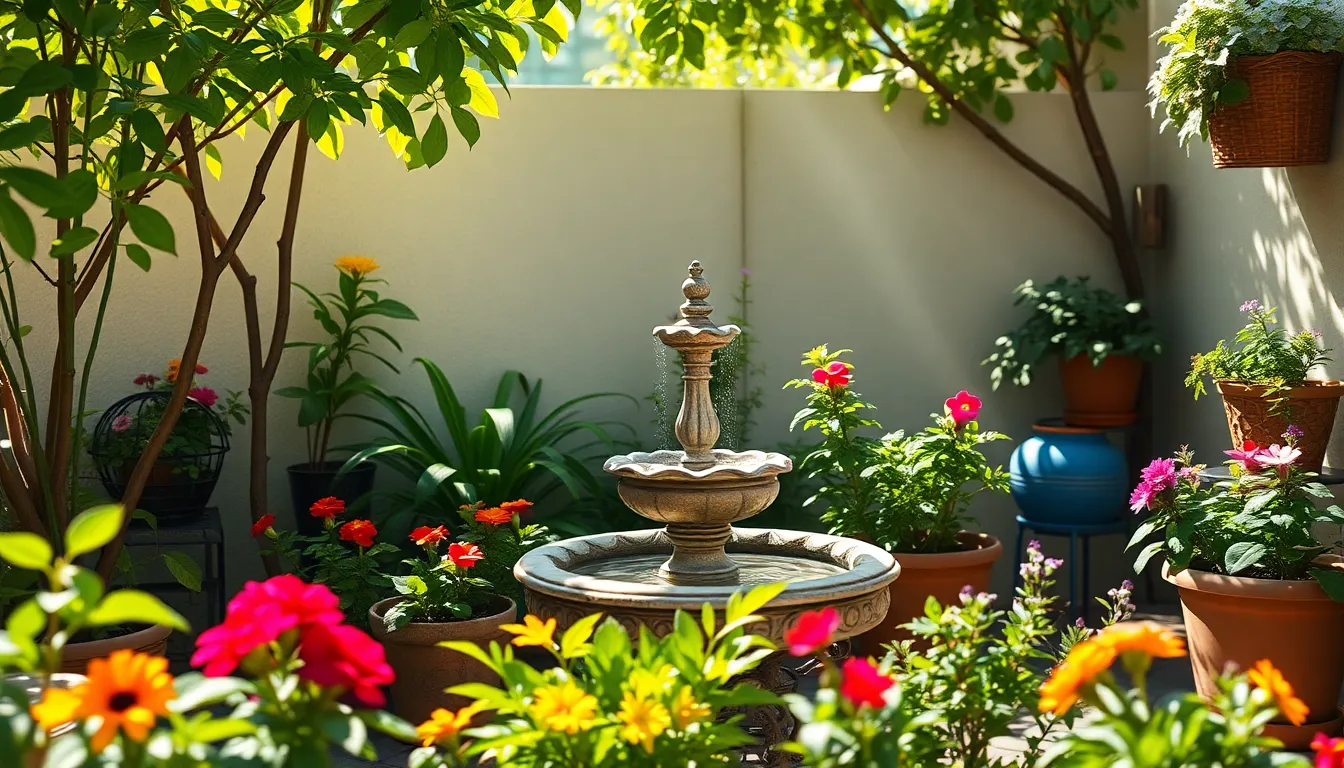
Adding water elements to your small patio garden creates peaceful sounds while supporting plant growth and humidity levels.
Install Small Fountains or Water Bowls
Small fountains transform compact patios into serene retreats with gentle flowing water sounds. We recommend positioning these features near seating areas to maximize their calming effect on both plants and people. Tabletop fountains work perfectly for tiny spaces, requiring minimal floor area while delivering maximum impact.
Water bowls offer versatility as both decorative elements and functional plant supports. Strategic placement in corners or along pathways creates focal points that draw the eye through your garden design. These features enhance visual appeal while providing natural humidity for surrounding plants.
Self contained fountain systems eliminate complicated plumbing requirements in rental properties. Electric models plug into standard outlets, while solar powered options reduce energy costs and provide placement freedom. Battery operated fountains offer complete portability for seasonal garden arrangements.
Create Mini Pond Gardens in Large Containers
Large containers become stunning water gardens that fit perfectly on small patios without permanent installation. We suggest using containers at least 20 inches wide to provide adequate water volume for plant health and temperature stability. Waterproof planters, old bathtubs, or decorative pots work excellently for these projects.
Aquatic plants like water lilies and lotus create beautiful floating displays in container ponds. Submerged plants such as hornwort and anacharis help maintain water clarity while providing oxygen. Adding small goldfish or mosquito fish controls pests naturally while creating movement and interest.
Maintenance becomes simple with proper container pond setup using aquatic plant fertilizers and small filtration systems. Weekly water level checks prevent evaporation issues during hot weather. Winter protection involves moving containers to sheltered locations or adding small heaters for year round enjoyment.
Add Misting Systems for Humidity Loving Plants
Misting systems create humid microclimates perfect for ferns, orchids, and tropical plants that struggle in dry patio conditions. Installation along walls or under patio covers provides consistent moisture without oversaturating soil. These systems work particularly well with vertical garden installations where natural humidity stays low.
Programmable timers allow precise humidity control throughout different seasons and weather patterns. We recommend setting misting cycles for early morning and late afternoon to prevent fungal issues while maximizing plant benefits. Fine mist nozzles distribute water evenly without creating puddles or runoff problems.
Integration with existing irrigation systems reduces installation complexity and maintenance requirements. Pressure compensating nozzles ensure consistent misting regardless of water pressure fluctuations. Anti drip valves prevent water waste between misting cycles, making these systems both efficient and environmentally friendly.
Use Creative DIY Solutions to Save Money
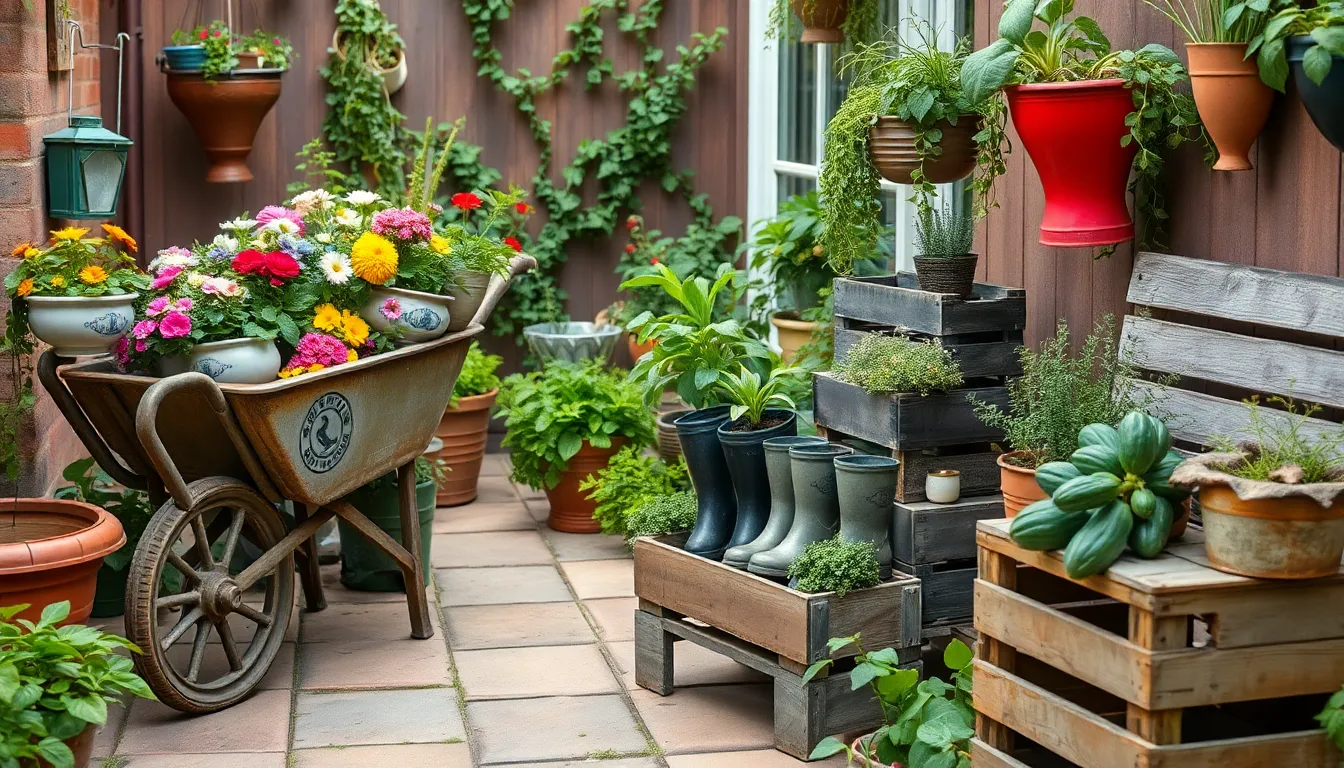
Creative DIY answers transform everyday household items into functional garden elements while keeping costs minimal. We’ll explore innovative approaches that maximize your small patio garden’s potential without straining your budget.
Repurpose Household Items as Unique Planters
Wheelbarrows make excellent rustic flower gardens when you drill drainage holes in the bottom. We recommend positioning these mobile planters near seating areas where their vintage charm adds character to your patio space.
Old colanders work perfectly as hanging planters for trailing herbs like thyme or oregano. Simply line them with coconut fiber and thread chains through the existing holes for instant suspension systems.
Boots and shoes create whimsical container gardens that add personality to your outdoor space. We suggest using rain boots for herbs since they’re already waterproof and provide adequate root space.
Wooden crates stack beautifully to form tiered planting systems for vegetables and flowers. Paint them with weather-resistant stain to protect against moisture while maintaining their rustic appeal.
Build Custom Shelving from Reclaimed Materials
Reclaimed wood offers endless possibilities for custom patio shelving that costs a fraction of store-bought alternatives. We’ve found that old fence boards and shipping pallets work exceptionally well for creating multi-level plant displays.
Ladder shelving systems provide vertical growing space while adding architectural interest to your garden. Position them against walls or use them as room dividers to separate different growing zones effectively.
Brick and board combinations create sturdy, adjustable shelving that accommodates plants of varying heights. We recommend using concrete blocks as alternatives since they’re often free from construction sites and equally durable.
Floating shelves mounted on exterior walls maximize space without cluttering your patio floor. Install them at different heights to create visual interest and provide optimal light exposure for various plant types.
Create Hanging Gardens from Recycled Containers
Plastic bottles transform into self-watering planters when you create a simple wick system using cotton string. We cut holes in the caps and thread the string through to create efficient irrigation systems for herbs and small vegetables.
Old buckets work wonderfully as hanging planters for larger plants like tomatoes or peppers. Drill drainage holes around the bottom and attach strong chains to support the weight of mature plants.
Mason jars create charming herb gardens when mounted on wooden boards with metal clamps. We position these displays near kitchen windows for easy access during meal preparation.
Fabric grow bags made from old t-shirts or canvas provide excellent drainage and root aeration. Sew simple drawstring tops to create portable planters that can be moved as needed for optimal sunlight exposure.
Conclusion
Transforming your small patio into a thriving garden space isn’t just possible—it’s incredibly rewarding. We’ve shown you how creative answers can multiply your growing potential while keeping maintenance simple and enjoyable.
From vertical growing systems to multi-functional furniture your compact outdoor area can become a productive oasis. The combination of smart plant selection efficient lighting and clever water features creates an environment that works year-round.
Remember that every small space has unique potential waiting to be unlocked. Start with one or two techniques that resonate with your lifestyle and gradually expand your garden as you gain confidence.
Your small patio garden journey begins with that first planted container. With these strategies you’re equipped to create an outdoor retreat that brings beauty function and fresh ingredients right to your doorstep.
Frequently Asked Questions
What plants work best for small patio gardens?
Compact varieties are ideal for small spaces. Choose dwarf fruit trees like apple and peach, compact vegetables such as cherry tomatoes and mini peppers, and space-saving herbs like basil and thyme. Trailing plants like ivy and petunias create cascading effects, while microgreens provide fresh ingredients with minimal space requirements.
How can I maximize vertical space in my small garden?
Install wall-mounted planters and trellises to utilize vertical surfaces without taking up floor space. Use ladder shelving for tiered plant displays, hang plants from ceiling hooks, and consider pulley systems for easy maintenance. These techniques can triple your planting capacity while keeping everything accessible.
What containers work best for patio gardening?
Self-watering containers with built-in reservoirs are excellent for consistent hydration and low maintenance. Group plants with similar watering needs in decorative pots, use tiered planters for visual impact, and consider window boxes for herbs. Choose lightweight materials to prevent structural stress on railings or surfaces.
How do I organize my small patio garden effectively?
Create defined growing zones by designating corners for larger statement plants and balancing them with smaller companions. Use strategic plant placement to create pathways and define functional areas. Plant screens made with trellises and tall planters can separate dining and growing zones while providing privacy.
Can I extend my growing season in a small patio garden?
Yes, proper lighting can make your patio productive year-round. Install LED grow lights under patio covers or on walls for supplemental illumination during shorter winter days. Use reflective surfaces like mirrors to redirect natural light to darker corners, and consider solar-powered lights for evening ambiance.
What are some budget-friendly DIY solutions for small gardens?
Transform household items into unique planters – use wheelbarrows, old colanders, or even boots as creative containers. Create custom shelving from reclaimed materials and build hanging gardens using repurposed items. These DIY solutions add character while maximizing growing potential without straining your budget.
How can water features benefit my small patio garden?
Small fountains or water bowls enhance visual appeal and increase humidity for plant growth. Mini pond gardens in large containers can house aquatic plants and provide natural pest control. Misting systems create humid microclimates for humidity-loving plants and can be integrated with existing irrigation systems.
What multi-functional furniture works well in patio gardens?
Storage benches with integrated planters provide organization while displaying colorful plants. Plant stands that double as side tables offer extra surface area for dining and showcase plants at eye level. Railing planters save floor space while keeping herbs and vegetables easily accessible for daily use.

